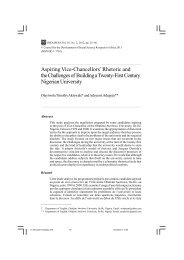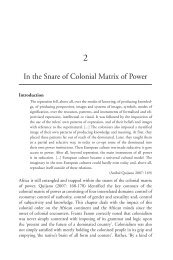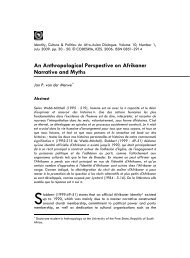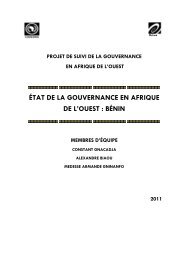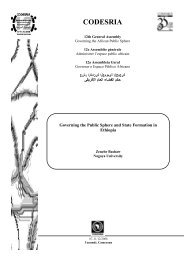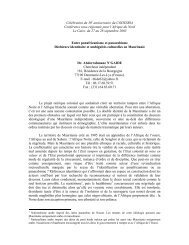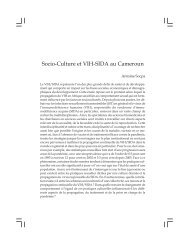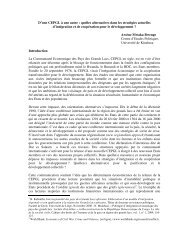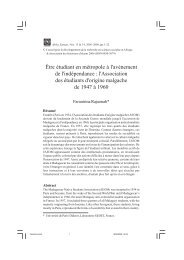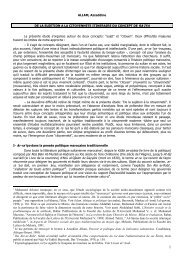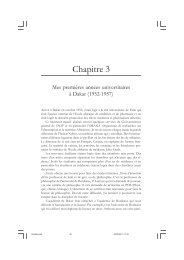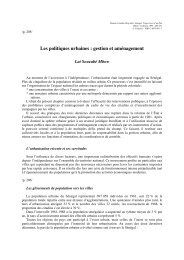Land and Agrarian Reform in Former Settler Colonial ... - codesria
Land and Agrarian Reform in Former Settler Colonial ... - codesria
Land and Agrarian Reform in Former Settler Colonial ... - codesria
You also want an ePaper? Increase the reach of your titles
YUMPU automatically turns print PDFs into web optimized ePapers that Google loves.
Murisa: Social Organisation <strong>in</strong> the Aftermath of ‘Fast Track’<br />
281<br />
Nature of the emerg<strong>in</strong>g local state <strong>in</strong> Fast Track areas<br />
When the GoZ rega<strong>in</strong>ed the <strong>in</strong>itiative <strong>in</strong> l<strong>and</strong> redistribution <strong>in</strong> late 2001 through<br />
the Fast Track Programme, some observers (Sadomba 2008a&b) saw this process<br />
as aimed at marg<strong>in</strong>alis<strong>in</strong>g the leadership of war veterans. The state sought to<br />
restore its plann<strong>in</strong>g authority (see Moyo 2005) us<strong>in</strong>g the Fast Track <strong>L<strong>and</strong></strong> <strong>Reform</strong><br />
legislation. Accord<strong>in</strong>g to one perspective, it focused on remov<strong>in</strong>g war veterans<br />
from the plots they had allocated themselves on the pretext of the need to rezone<br />
the l<strong>and</strong> either <strong>in</strong>to A1 or A2 farms (Sadomba 2008a: 187). Although the<br />
programme was often perceived as ‘chaotic’ <strong>in</strong> execution, it was implemented<br />
through a centralised mechanism that controlled decentralised structures from the<br />
local (farm) level up to the central government level (Chaumba et al 2003: 9-10).<br />
In the process, the Fast Track approach gave ‘a new impetus to local structures at<br />
a relatively low direct budgetary cost’ (Moyo <strong>and</strong> Yeros 2007b: 108). The defunct<br />
Village Development Committees (VIDCOs) were revived <strong>and</strong> reconstituted <strong>in</strong><br />
structure to be run by a seven member committee 36 (Chaumba et al 2003: 10).<br />
These were later subjected to the ‘traditional’ authority of village heads appo<strong>in</strong>ted<br />
by chiefs. At the district level there were District <strong>L<strong>and</strong></strong> Committees (DLCs), which<br />
<strong>in</strong>cluded the Rural District Council (RDC) Chairperson; the District Chairperson<br />
of the War Veterans Association; traditional leaders (chiefs <strong>and</strong> village heads);<br />
an officer from the President’s Office (Intelligence), the Zimbabwe Republic<br />
Police (ZRP) <strong>and</strong> the Zimbabwe National Army (ZNA); <strong>and</strong> officials from the<br />
departments of Social Welfare, Health, Veter<strong>in</strong>ary <strong>and</strong> Agricultural Research <strong>and</strong><br />
Extension (AREX). The responsibilities of the DLC <strong>in</strong>cluded identification of l<strong>and</strong><br />
for resettlement, beneficiary selection <strong>and</strong> attend<strong>in</strong>g to l<strong>and</strong> disputes among the<br />
newly resettled farmers (GoZ 2001). The DLC reported to similarly constituted<br />
prov<strong>in</strong>cial l<strong>and</strong> committees, coord<strong>in</strong>ated by prov<strong>in</strong>cial governors, who <strong>in</strong> turn<br />
reported to the central government (Moyo <strong>and</strong> Yeros 2007b: 108).<br />
Parallel to the reconfiguration of the local state, new power relations have<br />
emerged. While dur<strong>in</strong>g the period of Jambanja the role of traditional leaders <strong>in</strong><br />
beneficiary selection was overridden by war veterans, the former were elevated<br />
dur<strong>in</strong>g the Fast Track Programme. The chiefs managed to weave their way<br />
<strong>in</strong>to official structures <strong>and</strong> advocated for the expansion of their territories <strong>in</strong>to<br />
neighbour<strong>in</strong>g resettlement areas. While the pronounced role of traditional<br />
authority <strong>in</strong> beneficiary selection <strong>and</strong> the expansion of territorial control were<br />
logistically rational, especially <strong>in</strong> beneficiary selection, it re<strong>in</strong>forced customary<br />
authority as a whole, giv<strong>in</strong>g sustenance to possibilities of ethno-regional biases<br />
<strong>in</strong> l<strong>and</strong> allocation (Moyo <strong>and</strong> Yeros 2007b: 111). The local leadership of war<br />
veterans, once dom<strong>in</strong>ant with<strong>in</strong> the Committees of Seven at village level <strong>and</strong><br />
<strong>L<strong>and</strong></strong> <strong>and</strong> <strong>Agrarian</strong> <strong>Reform</strong> <strong>in</strong> <strong>Former</strong> <strong>Settler</strong> <strong>Colonial</strong> Zimbabwe.<strong>in</strong>dd 281 28/03/2013 12:57:32



